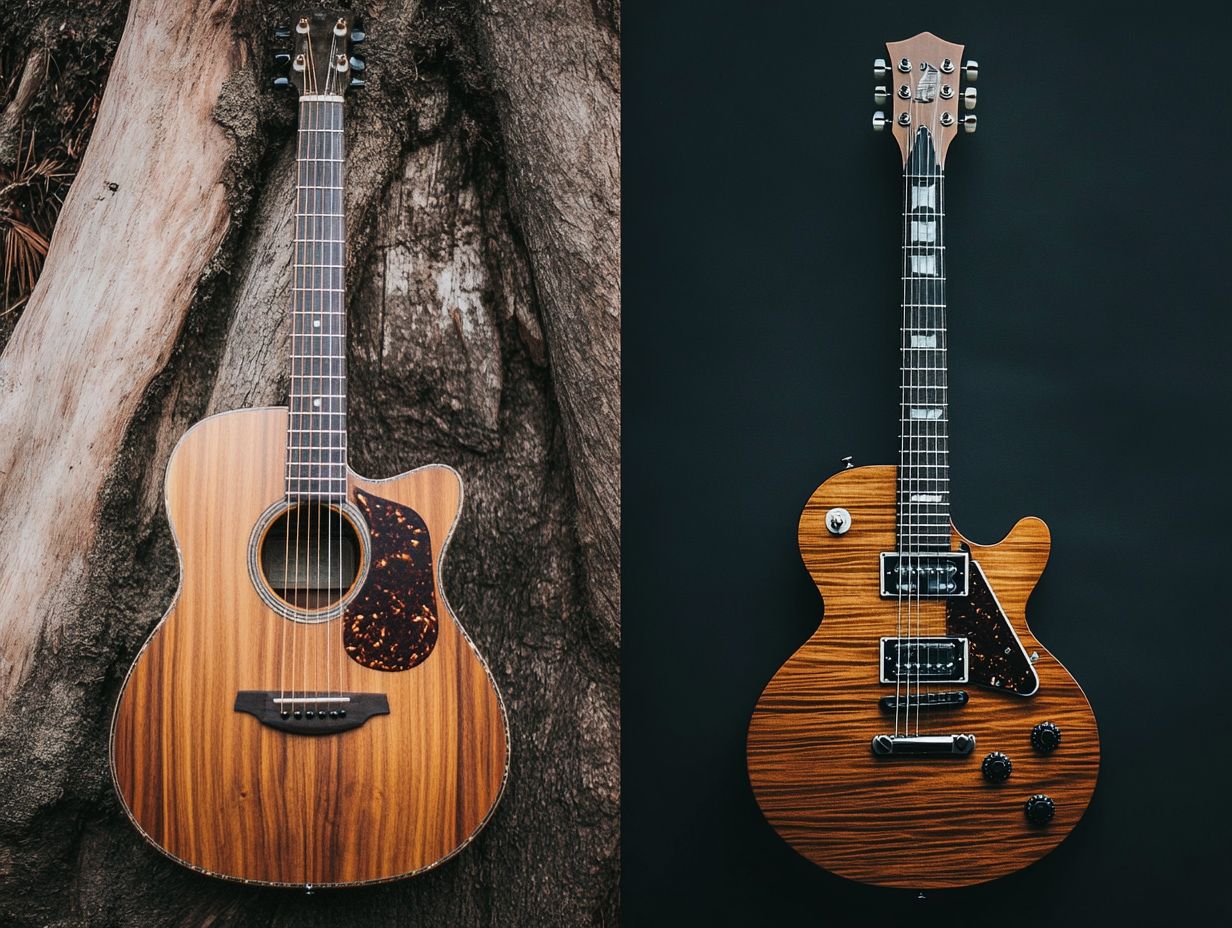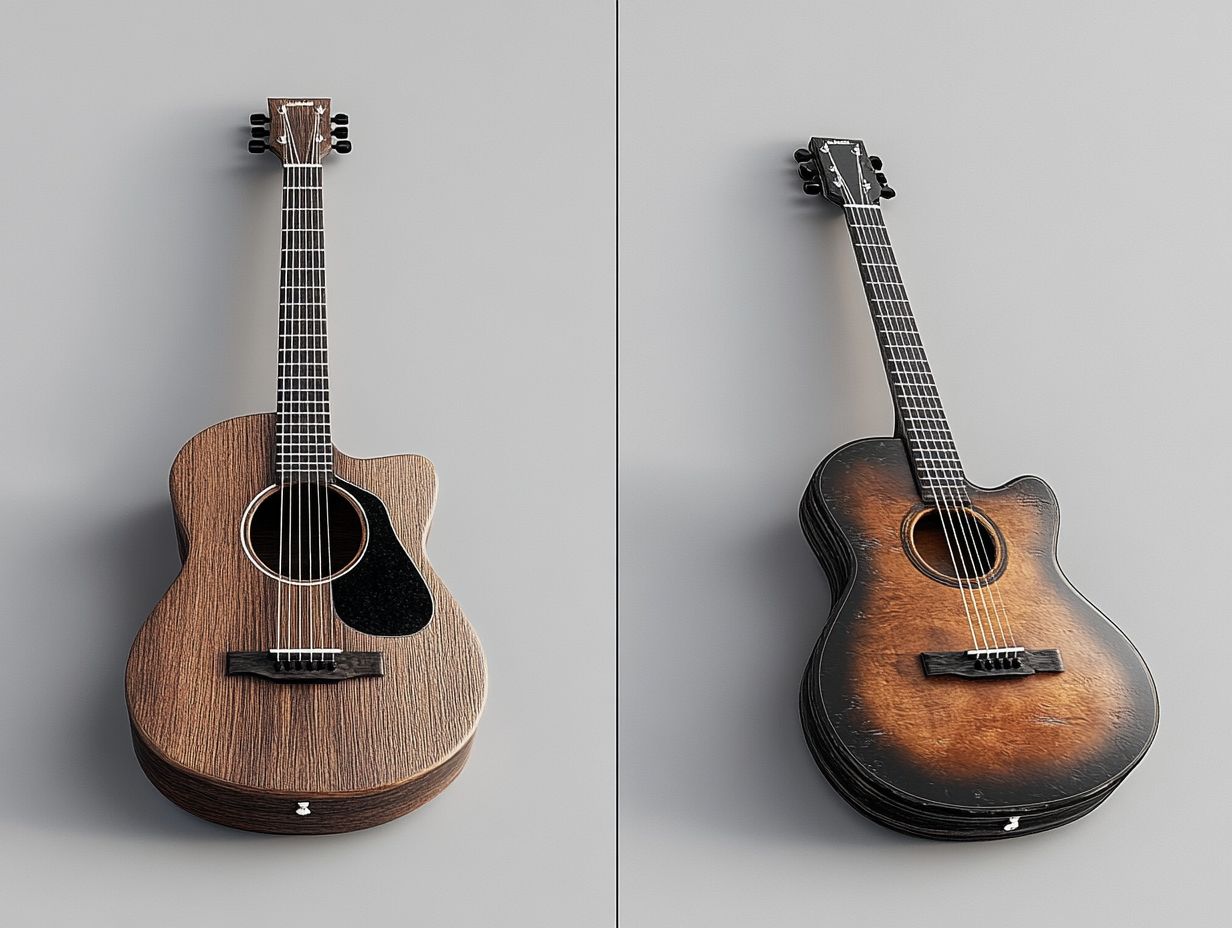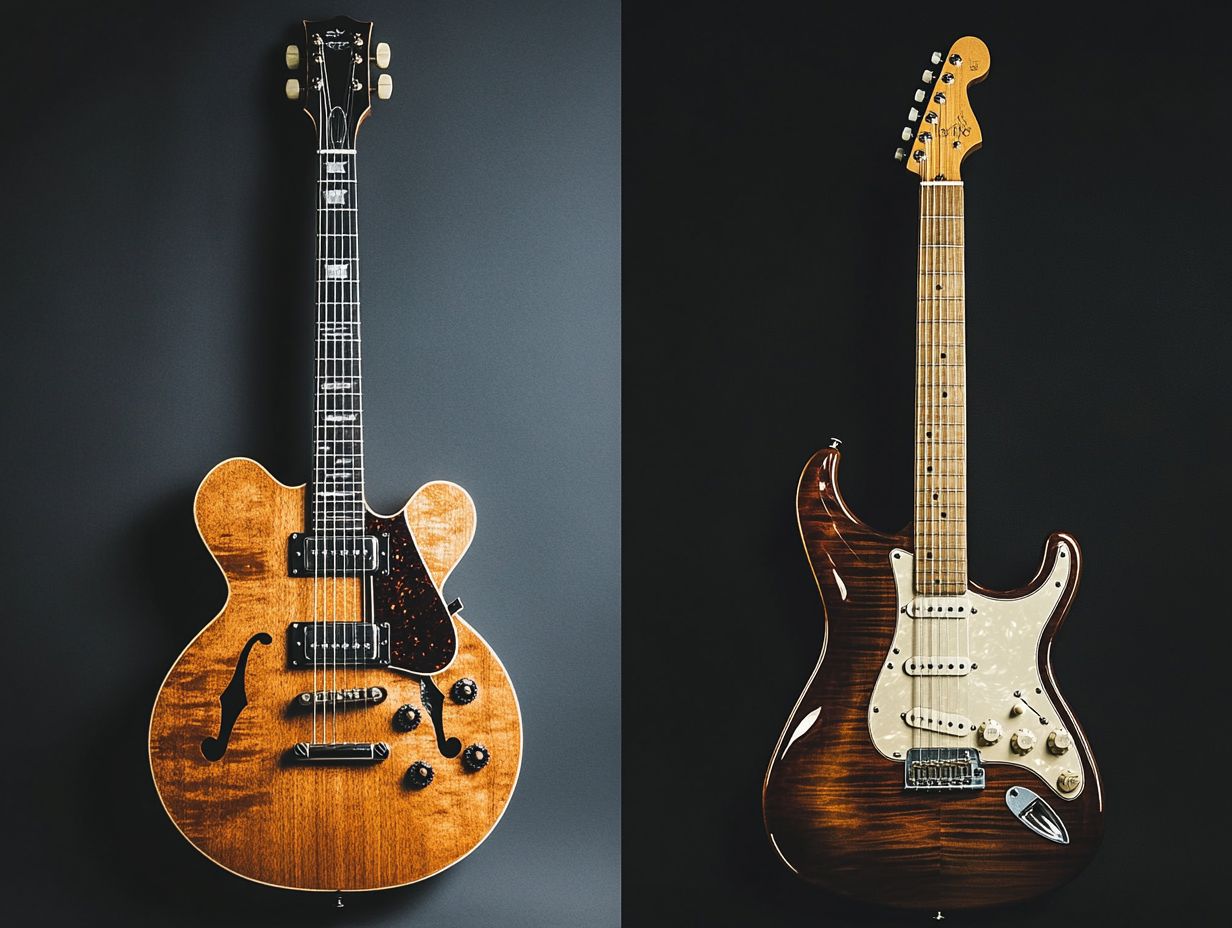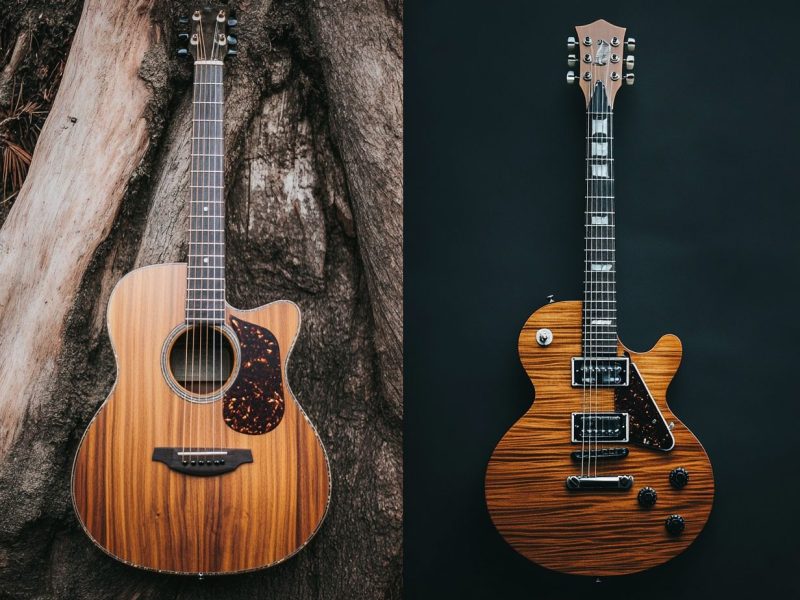When selecting the appropriate guitar, the decision typically narrows down to two primary options: acoustic and electric.
Each type possesses its distinct sound, playing style, and appeal, rendering them suitable for various music genres and individual preferences.
This article examines the fundamental differences in sound quality and tone, analyzes the various playing styles, and discusses the factors influencing cost and maintenance.
Regardless of whether one is a novice or an experienced player, comprehending these distinctions will facilitate an informed decision for one’s musical journey.
Overview of the Two Types of Guitars

Understanding the distinctions between the two primary types of guitars—acoustic and electric—is crucial for both musicians and enthusiasts.
Acoustic guitars, renowned for their rich sound quality and versatility, generally feature a hollow body design that facilitates natural resonance and sound projection. In contrast, electric guitars employ amplification systems, making them suitable for a wide range of genres and performance styles.
Each type of guitar possesses unique characteristics concerning body style, playability, and maintenance requirements, catering to various musical expressions and player preferences.
Acoustic guitars typically produce a warmer tone, rendering them ideal for folk, country, and classical music, where the emphasis is placed on organic sound. Their construction often involves solid or laminated woods, which significantly impact their tonal qualities.
Electric guitars, characterized by their solid body designs, are capable of generating a broader spectrum of sounds due to the incorporation of pickups that amplify and modify tones, making them well-suited for genres such as rock, jazz, and metal. Their versatility is further enhanced by effects pedals that provide a range of sound dynamics.
Ultimately, both types of guitars occupy distinct roles within the music industry, enabling musicians to explore diverse styles and create unique soundscapes.
Sound Production
The sound production of acoustic and electric guitars is influenced by their distinct characteristics, including sound quality, tone, and resonance.
Acoustic guitars are renowned for their natural brightness and warmth, which is generated by the vibration of the strings resonating within a hollow body that enhances sound projection.
In contrast, electric guitars utilize pickups and amplification to shape their sound, providing a broad spectrum of tonal possibilities that can be customized through various effects pedals and hardware configurations.
Differences in Sound Quality and Tone
The distinctions in sound quality and tone between acoustic and electric guitars play a significant role in influencing a musician’s choice and playing style. Acoustic guitars produce a warm, resonant tone that is particularly suited to genres such as folk and classical music.
In contrast, electric guitars offer a brighter, more versatile sound that can adapt across various musical styles, including rock and jazz. These tonal differences are shaped by several factors, including string gauge, body type, and the construction of the guitar, all of which impact the overall sound dynamics experienced during performance.
The playability of each type varies due to their inherent characteristics. For example, the arrangement of strings on an electric guitar facilitates easier bends and expressive techniques, making it a preferred choice in genres that require complex solos or heavy distortion. Conversely, the natural acoustic projection of an acoustic guitar is often ideal for singer-songwriters seeking a more organic sound.
Regarding amplification, electric guitars offer a level of customization that can significantly enhance tone. Through the use of effects and nuances tailored to specific musical contexts, electric guitars ultimately shape the artist’s unique sound expression.
Playing Styles
The playing styles for acoustic and electric guitars differ significantly, shaped by the physical characteristics of each instrument and the musical genres they are designed to complement.
Acoustic guitarists frequently employ fingerstyle techniques to produce intricate melodies and rhythms that take advantage of the guitar’s natural resonance. In contrast, electric guitarists utilize a wider array of playing styles, including strumming, lead guitar solos, and effects manipulation.
This versatility enables a more dynamic expression of music across various genres.
How Each Type of Guitar is Played

The playing techniques for acoustic and electric guitars are specifically tailored to the strengths of each instrument, providing musicians with distinct approaches to musical expression.
Acoustic guitarists often utilize fingerstyle techniques, which facilitate a nuanced performance that accentuates the warmth and resonance of the instrument. In contrast, electric guitarists may employ a broader range of playing methods, including strumming and lead guitar solos, which leverage the instrument’s capabilities for sound shaping and amplification.
Both types of guitarists have access to an extensive array of techniques that align with their individual styles. For example, the techniques of palm muting and harmonics employed by electric guitarists can produce an edgy sound that is particularly effective in rock and blues genres.
Conversely, acoustic players frequently incorporate techniques such as sliding and hammer-ons to convey emotion and add depth to their music. The fingerpicking styles adopted by acoustic musicians not only enhance melodic lines but also facilitate intricate rhythmic patterns that can be truly captivating.
Ultimately, the choices made by each guitarist regarding their playing style highlight the unique characteristics and artistic expressions that emerge from both acoustic and electric domains.
Cost and Maintenance
The costs and maintenance requirements of acoustic and electric guitars can differ significantly depending on factors such as brand, craftsmanship, and available features. Therefore, it is essential for musicians to evaluate their budget and long-term objectives carefully.
Acoustic guitars are frequently regarded as more accessible for beginners due to their simpler design and reduced maintenance demands. In contrast, electric guitars typically necessitate a higher investment in amplification systems and effects pedals.
A comprehensive understanding of the pricing landscape and maintenance needs is vital for making well-informed purchasing decisions that correspond with individual skill levels and musical aspirations.
Factors Affecting Price and Upkeep
Several factors can influence the pricing and maintenance of acoustic and electric guitars, including brand reputation, material quality, and prevailing market trends. Generally, instruments of higher quality, constructed from premium tonewoods and exhibiting advanced craftsmanship, tend to demand higher prices.
Additionally, these instruments often require meticulous maintenance to preserve their sound quality and playability. Understanding these factors is essential for musicians, regardless of whether they are beginners or advanced players, in making informed purchasing decisions.
The crafting process itself, which encompasses both skilled artistry and innovative technology, significantly affects not only the cost but also the unique character of each instrument. The selection of woods, such as mahogany or spruce, can influence tonal qualities, while the incorporation of custom features may further elevate prices.
Moreover, market trends can fluctuate rapidly; for instance, a surge in popularity for vintage models may impact resale values and new purchases alike. Consequently, staying informed about current trends and understanding how they relate to individual preferences can greatly assist players in navigating the complexities of the guitar market.
Versatility and Genre Suitability
The versatility and genre suitability of acoustic and electric guitars significantly contribute to their popularity among musicians across various musical styles.
Acoustic guitars are frequently preferred in folk, country, and classical genres due to their warm, organic sound. In contrast, electric guitars are well-suited for rock, blues, and pop music because of their ability to produce a broad array of tones and effects.
This adaptability enables musicians to explore diverse performance styles and enhances their overall musicianship.
Which Type of Guitar is Best for Different Music Styles?

Selecting the appropriate type of guitar is crucial, as it can significantly impact a musician’s capacity to perform across various musical styles. Therefore, it is important to consider the distinct characteristics of both acoustic and electric guitars.
The acoustic guitar is celebrated for its warmth and resonance, rendering it an excellent option for singer-songwriters and performers who excel in intimate settings, where the natural sound can adequately fill the space without the necessity for amplification. Its rich tonal quality enhances melodies, particularly in genres such as bluegrass and country, where storytelling plays a pivotal role.
Conversely, the electric guitar provides a diverse range of sounds that can be shaped using various effects pedals, making it particularly appealing to artists in genres like metal and pop, where sonic experimentation is commonplace. Its capacity to sustain notes and deliver a sharper attack enhances fast riffs and solos, rendering it essential for creating a dynamic musical experience.
Personal Preference and Skill Level
When choosing between acoustic and electric guitars, personal preference and skill level are critical factors that can greatly influence a musician’s learning experience and performance.
For beginners, acoustic guitars typically present a more straightforward learning curve and are often regarded as more accessible.
In contrast, electric guitars provide advanced players with a wider array of techniques and tonal options, making them particularly suitable for those interested in exploring diverse playing styles and advanced techniques.
Factors to Consider when Choosing Between Acoustic and Electric Guitars
Several factors influence the decision between acoustic and electric guitars, including personal preference, skill level, and maintenance requirements. Musicians must evaluate the style of music they intend to play and determine which type of guitar aligns more closely with their personal expression.
A comprehensive understanding of the maintenance needs associated with each guitar type can contribute to a long-lasting and enjoyable playing experience.
When considering this choice, it is imperative for players to reflect on their current skill level and their desired pace of progress. Beginners may find that acoustic guitars offer a more straightforward approach, often requiring less technical setup than their electric counterparts. Conversely, electric guitars provide a unique appeal, presenting a diverse range of tones and textures that can inspire creativity.
Maintenance is another critical consideration; electric guitars often require regular attention to their pickups and wiring, while acoustic guitars necessitate care for their wooden components.
Ultimately, evaluating these factors enables musicians to select an instrument that not only aligns with their aspirations but also serves as a true companion throughout their musical journey.
Frequently Asked Questions
What is the difference between acoustic guitar and electric guitar?

Acoustic guitars produce sound through the vibration of the strings while electric guitars require an amplifier to produce sound.
Which is easier to play, acoustic or electric guitar?
This depends on personal preference and playing style. Acoustic guitars have thicker strings which may be more difficult for beginners, while electric guitars require more equipment and knowledge to produce sound.
Can you use the same techniques on both acoustic and electric guitar?
Yes, many techniques such as strumming, picking and chord shapes can be used on both types of guitars. However, the sound and tone may vary.
What type of music is best suited for acoustic guitar and electric guitar?
Acoustic guitars are commonly used in folk, country, and singer-songwriter genres while electric guitars are popular in rock, metal, and pop music. However, both types of guitars can be used in a variety of genres.
Which is more expensive, acoustic or electric guitar?
The price of both types of guitars can vary greatly depending on brand, quality, and features. However, in general, electric guitars tend to be more expensive due to the additional equipment needed for amplification.
Can you convert an acoustic guitar into an electric guitar?
It is possible to convert an acoustic guitar into an electric guitar by adding a pickup and connecting it to an amplifier. However, the resulting sound may not be the same as a traditional electric guitar.


 Get High-Quality Sound Without Breaking the Bank: Top Budget Audio Interfaces
Get High-Quality Sound Without Breaking the Bank: Top Budget Audio Interfaces